Posted on July 3rd, 2011 by Mary Lord
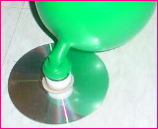 Understanding how friction works helps engineers design moving objects so they can be controlled. In this activity, students in grades 7 – 9 gain first-hand experience on how friction affects motion by building a hovercraft that uses air from a balloon to levitate a craft made from a compact disc (CD).
Understanding how friction works helps engineers design moving objects so they can be controlled. In this activity, students in grades 7 – 9 gain first-hand experience on how friction affects motion by building a hovercraft that uses air from a balloon to levitate a craft made from a compact disc (CD).
Read More
Filed under: Grades 6-8, Lesson Plans | Comments Off on Lesson: Hovercraft Racers
Tags: Class Activities, friction, hovercraft, Lesson Plan, Physics
Posted on June 19th, 2011 by Mary Lord
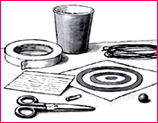 In this lesson, teams of students in grades 6 to 12 will explore the engineering design process by modifying a paper cup to carry a marble down a zip line and drop it precisely on a target. They will learn to brainstorm, test, evaluate, and redesign their devices to improve accuracy and effectiveness of the remote-release mechanism.
In this lesson, teams of students in grades 6 to 12 will explore the engineering design process by modifying a paper cup to carry a marble down a zip line and drop it precisely on a target. They will learn to brainstorm, test, evaluate, and redesign their devices to improve accuracy and effectiveness of the remote-release mechanism.
Read More
Filed under: Grades 6-8, Grades 9-12, Lesson Plans | 2 Comments »
Tags: Class Activities, Grades 6-8, Grades 9-12, Lesson Plan, Mechanical engineering, Physics, zip line
Posted on June 5th, 2011 by ASEE
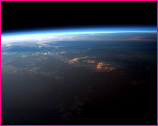 Two Houston engineers have won a competition for low-cost experiments that high school students could send aboard a suborbital space flight. They have designed an inexpensive microgravity spaceflight kit that allows students to conduct three experiments demonstrating important principles of science and engineering.
Two Houston engineers have won a competition for low-cost experiments that high school students could send aboard a suborbital space flight. They have designed an inexpensive microgravity spaceflight kit that allows students to conduct three experiments demonstrating important principles of science and engineering.
Read More
Filed under: K-12 Education News | Comments Off on DIY Space-flight Experiments for High Schoolers
Tags: Aeronautics, Aerospace, Aerospace Engineering, Competition, Competitions for Students, NASA, Physics, Space
Posted on May 22nd, 2011 by Mary Lord
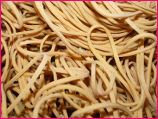 In this activity, teams of students 8 – 18 learn about engineering design by constructing rubber-band-powered cars from everyday materials that can travel in a straight line for a distance of at least 3 meters within a 1 meter wide track. They test their rubber-band racers, evaluate their results, and present to the class.
In this activity, teams of students 8 – 18 learn about engineering design by constructing rubber-band-powered cars from everyday materials that can travel in a straight line for a distance of at least 3 meters within a 1 meter wide track. They test their rubber-band racers, evaluate their results, and present to the class.
Read More
Filed under: Grades 6-8, Grades K-5, Lesson Plans | 2 Comments »
Tags: Class Activities, force, Grades 6-8, Grades K-5, Lesson Plan, Lesson Plans, motion, Physics, propulsion, rubber band racers
Posted on March 27th, 2011 by ASEE
 In this lesson, you’ll introduce your students to the four forces of flight–drag, lift, thrust, and weight–through a variety of fun-filled flight experiments. Students will “fly” for short periods and then evaluate factors that might either increase or decrease their “flight” duration.
In this lesson, you’ll introduce your students to the four forces of flight–drag, lift, thrust, and weight–through a variety of fun-filled flight experiments. Students will “fly” for short periods and then evaluate factors that might either increase or decrease their “flight” duration.
Read More
Filed under: Class Activities, Grades 6-8, Grades 6-8, Grades K-5, Grades K-5, Lesson Plans | 1 Comment »
Tags: Aerodynamics, Aeronautics, Class Activities, Lesson Plan, Physics
Posted on March 27th, 2011 by Mary Lord
 It’s easy to find your way to school. Now imagine trying to navigate the skies, with no signs to point you in the right direction. How do pilots find their way? These “pilot training lessons” developed by the Center for Innovation in Engineering and Science Education at the Stevens Institute of Technology will teach your young aviators the principles of navigation in a fun series of real-time activities.
It’s easy to find your way to school. Now imagine trying to navigate the skies, with no signs to point you in the right direction. How do pilots find their way? These “pilot training lessons” developed by the Center for Innovation in Engineering and Science Education at the Stevens Institute of Technology will teach your young aviators the principles of navigation in a fun series of real-time activities.
Read More
Filed under: Class Activities, Grades 6-8, Grades 6-8, Grades 9-12, Grades K-5, Lesson Plans, Web Resources | 2 Comments »
Tags: Aeronautics, Aerospace, airplane, Class Activities, flight, Grades 6-8, Lesson Plan, Mathematics, NASA, Physics, vectors, windspeed
Posted on March 20th, 2011 by Mary Lord
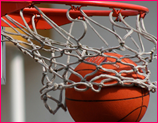 Basketball not only is fun to play or watch–it packs a lot of math and science in each move. In this lesson, developed by NPR’s Talking Science with John Fontanella, a physicist at the U.S. Naval Academy and author of The Physics of Basketball, students will learn how physics affects the game. What forces are acting on the ball? What must players do to offset these forces?
Basketball not only is fun to play or watch–it packs a lot of math and science in each move. In this lesson, developed by NPR’s Talking Science with John Fontanella, a physicist at the U.S. Naval Academy and author of The Physics of Basketball, students will learn how physics affects the game. What forces are acting on the ball? What must players do to offset these forces?
Read More
Filed under: Class Activities, Grades 6-8, Grades 6-8, Lesson Plans | Comments Off on Lesson: Free Shot Physics
Tags: Class Activities, Grades 6-8, Lesson Plan, Lesson Plans, Physics
Posted on March 13th, 2011 by Jaimie Schock
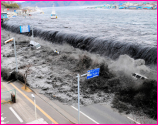 Water is surprisingly heavy, and, when in motion, it can kill. The tsunami that hit Northern Japan on Friday is an eye-opening example of the power water can have—and the devastation it can bring. “It’s basically like a hundred tanks coming across you,” oceanography professor Philip Froelich says.
Water is surprisingly heavy, and, when in motion, it can kill. The tsunami that hit Northern Japan on Friday is an eye-opening example of the power water can have—and the devastation it can bring. “It’s basically like a hundred tanks coming across you,” oceanography professor Philip Froelich says.
Read More
Filed under: Special Features | Comments Off on Feature: Tsunami Waves’ Destructive Power
Tags: Japan, Ocean, Ocean science, Physics, Water
Posted on March 13th, 2011 by Mary Lord
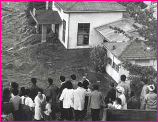 From buildings that sway rather than collapse to tsunami seawalls and drills, Japan’s earthquake precautions have made the nation uniquely prepared for disaster. Learn how Japanese construct skyscrapers and other earthquake-resistant engineering in this New York Times feature. Such practices undoubtedly helped save lives, though the toll from last week’s temblor and giant wave continues to mount.
From buildings that sway rather than collapse to tsunami seawalls and drills, Japan’s earthquake precautions have made the nation uniquely prepared for disaster. Learn how Japanese construct skyscrapers and other earthquake-resistant engineering in this New York Times feature. Such practices undoubtedly helped save lives, though the toll from last week’s temblor and giant wave continues to mount.
Read More
Filed under: Class Activities, Grades 6-8, Grades 9-12, Lesson Plans, Special Features | Comments Off on Feature: Engineered for Earthquakes
Tags: Curriculum, Environmental Engineering, Japan, Lesson Plan, Physics
 Understanding how friction works helps engineers design moving objects so they can be controlled. In this activity, students in grades 7 – 9 gain first-hand experience on how friction affects motion by building a hovercraft that uses air from a balloon to levitate a craft made from a compact disc (CD).
Understanding how friction works helps engineers design moving objects so they can be controlled. In this activity, students in grades 7 – 9 gain first-hand experience on how friction affects motion by building a hovercraft that uses air from a balloon to levitate a craft made from a compact disc (CD). 








 In this lesson, teams of students in grades 6 to 12 will explore the engineering design process by modifying a paper cup to carry a marble down a zip line and drop it precisely on a target. They will learn to brainstorm, test, evaluate, and redesign their devices to improve accuracy and effectiveness of the remote-release mechanism.
In this lesson, teams of students in grades 6 to 12 will explore the engineering design process by modifying a paper cup to carry a marble down a zip line and drop it precisely on a target. They will learn to brainstorm, test, evaluate, and redesign their devices to improve accuracy and effectiveness of the remote-release mechanism. Two Houston engineers have won a competition for low-cost experiments that high school students could send aboard a suborbital space flight. They have designed an inexpensive microgravity spaceflight kit that allows students to conduct three experiments demonstrating important principles of science and engineering.
Two Houston engineers have won a competition for low-cost experiments that high school students could send aboard a suborbital space flight. They have designed an inexpensive microgravity spaceflight kit that allows students to conduct three experiments demonstrating important principles of science and engineering. In this activity, teams of students 8 – 18 learn about engineering design by constructing rubber-band-powered cars from everyday materials that can travel in a straight line for a distance of at least 3 meters within a 1 meter wide track. They test their rubber-band racers, evaluate their results, and present to the class.
In this activity, teams of students 8 – 18 learn about engineering design by constructing rubber-band-powered cars from everyday materials that can travel in a straight line for a distance of at least 3 meters within a 1 meter wide track. They test their rubber-band racers, evaluate their results, and present to the class. In this lesson, you’ll introduce your students to the four forces of flight–drag, lift, thrust, and weight–through a variety of fun-filled flight experiments. Students will “fly” for short periods and then evaluate factors that might either increase or decrease their “flight” duration.
In this lesson, you’ll introduce your students to the four forces of flight–drag, lift, thrust, and weight–through a variety of fun-filled flight experiments. Students will “fly” for short periods and then evaluate factors that might either increase or decrease their “flight” duration. It’s easy to find your way to school. Now imagine trying to navigate the skies, with no signs to point you in the right direction. How do pilots find their way? These “pilot training lessons” developed by the Center for Innovation in Engineering and Science Education at the Stevens Institute of Technology will teach your young aviators the principles of navigation in a fun series of real-time activities.
It’s easy to find your way to school. Now imagine trying to navigate the skies, with no signs to point you in the right direction. How do pilots find their way? These “pilot training lessons” developed by the Center for Innovation in Engineering and Science Education at the Stevens Institute of Technology will teach your young aviators the principles of navigation in a fun series of real-time activities. Basketball not only is fun to play or watch–it packs a lot of math and science in each move. In this lesson, developed by NPR’s Talking Science with John Fontanella, a physicist at the U.S. Naval Academy and author of The Physics of Basketball, students will learn how physics affects the game. What forces are acting on the ball? What must players do to offset these forces?
Basketball not only is fun to play or watch–it packs a lot of math and science in each move. In this lesson, developed by NPR’s Talking Science with John Fontanella, a physicist at the U.S. Naval Academy and author of The Physics of Basketball, students will learn how physics affects the game. What forces are acting on the ball? What must players do to offset these forces?  Water is surprisingly heavy, and, when in motion, it can kill. The tsunami that hit Northern Japan on Friday is an eye-opening example of the power water can have—and the devastation it can bring. “It’s basically like a hundred tanks coming across you,” oceanography professor Philip Froelich says.
Water is surprisingly heavy, and, when in motion, it can kill. The tsunami that hit Northern Japan on Friday is an eye-opening example of the power water can have—and the devastation it can bring. “It’s basically like a hundred tanks coming across you,” oceanography professor Philip Froelich says. From buildings that sway rather than collapse to tsunami seawalls and drills, Japan’s earthquake precautions have made the nation uniquely prepared for disaster. Learn how Japanese construct skyscrapers and other earthquake-resistant engineering in this New York Times feature. Such practices undoubtedly helped save lives, though the toll from last week’s temblor and giant wave continues to mount.
From buildings that sway rather than collapse to tsunami seawalls and drills, Japan’s earthquake precautions have made the nation uniquely prepared for disaster. Learn how Japanese construct skyscrapers and other earthquake-resistant engineering in this New York Times feature. Such practices undoubtedly helped save lives, though the toll from last week’s temblor and giant wave continues to mount.